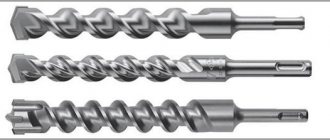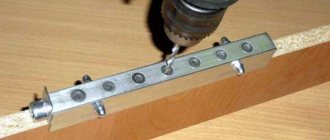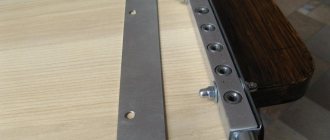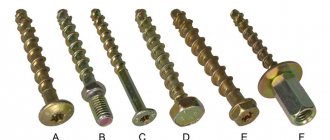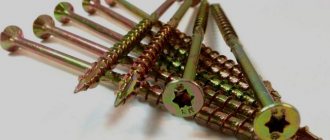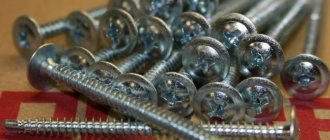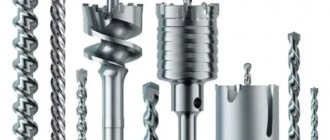Beton-House.com
Website about concrete: construction, characteristics, design. We combine the experience of professionals and private craftsmen in one place
Types of screws for concrete
A concrete screw or dowel is a cylindrical, elongated part with a head on one side, a thread in the center and a sharp end on the other side. The head of the element can have the form of a hexagon or a cross groove in its center.
For the manufacture of dowels, high-hardness carbon steel is used, which makes the concrete screw quite strong, and the application of a special protective coating protects the elements from corrosion and improves mechanical properties. The article introduces the types of screws and methods of using them on concrete.
Conclusion
Self-tapping screws for concrete – product range
Hardware products used for installation in concrete foundations are classified according to the following criteria:
- according to the shape and pitch of the thread on the screw rod;
- by head configuration;
- by type of protective coating.
It is advisable to use self-tapping screws for concrete in places where other types of fastening cannot be used due to the fragility of the base or the complexity of installation
Based on the shape of the head, it is customary to distinguish the following self-tapping screws for concrete:
- screw with a countersunk head (conical shape with cross-shaped slots);
- products with a hexagonal head (with cross-slots, internal threads, for an open-end or socket wrench);
- stud screws (for a nut, with a threaded drive);
- crocheted screws with round or rectangular heads.
The head configuration affects the mounting principle of the fastener. The studs and hooks are mounted in a pre-drilled hole and filled with sealing material. The rest of the products are fixed without drilling and with drilling - screws with a countersunk, hexagonal head can be used without preparing a mounting hole with a drill, but such installation is acceptable on lightweight concrete.
Based on the properties of the protective coating, fasteners are classified into:
- black screws (with oxidized coating) - used in rooms with a stable normal level of humidity;
- silver – the material is coated with a zinc layer, which allows it to be used everywhere;
- yellow – coated with a copper layer and recommended for indoor installation.
According to the characteristics of the thread, it is customary to distinguish:
- universal fasteners – length 12-220 mm, d 3-6 mm. The rod has a standard helical groove cut into it. The product is mounted into a wall made of light and heavy concrete. In the latter case, a mounting hole is used (for a dowel);
- universal fasteners with herringbone thread - length 12-200 mm, d 3-8 mm. Installation is carried out in prepared mounting holes with a polymer sleeve. The depth of the groove should exceed the length of the screw by 3-5 mm. For work, use an impact driver or a simple screwdriver;
- screws with variable notch (thread) – length 70-200 mm, d5 mm. The dowel is screwed into concrete walls without prior preparation. To screw in the self-tapping screw, you must use a screwdriver.
Features of using self-tapping screws
Using such fasteners is quite convenient and simple.
The instructions recommend drilling a hole in advance before screwing a screw into a concrete wall. Before screwing a screw into concrete, you will need:
- Hammer drill, electric drill, screwdriver;
- Drill bit for concrete screwdriver;
Tip: It should be borne in mind that there is no clear answer to the question of whether it is possible to drill concrete with a screwdriver. In this case, work should be carried out very carefully and only as a last resort.
- Regular screwdriver . Its choice depends on the shape of the slot applied to the dowel head. Most often it is cross-shaped or curly, the screwdriver should be of the same type;
- Hammer. Sometimes they are allowed to drive self-tapping screws into the wall. But only in situations where: there is no special tool available for drilling a hole; there will be no significant load on the fastener, for example, it will be intended for attaching a picture.
How to screw in a dowel
Self-tapping screws are used when installing plastic windows, any wooden structures, different profiles, door frames to a concrete or other base.
Before screwing a self-tapping screw into the concrete, a hole is drilled in the wall. It is necessary to take into account that:
- The distance from the edge of the wall should not be less than 60 mm;
- When installing a plastic window, the pitch between fasteners is selected to be a maximum of 60 cm;
- When installing an aluminum or wooden window, the maximum step between elements can be 70 cm.
Further:
- After drilling a hole, it is cleared of dust;
- A dowel of the required size is inserted. It can be plastic or wooden, the main thing is that it can withstand fasteners and be securely fastened to the concrete wall;
- A self-tapping screw is screwed in, as shown in the photo.
Tip: To avoid breaking off the screw, you must screw it in correctly. This should be done carefully, without over-tightening the fasteners. You should avoid fast screwing in, which can lead to overheating of the element head and its destruction.
Concrete dowel - technical specifications
Self-tapping screws (without drilling concrete) are made on the basis of hardened steel , which gives the product increased strength. A yellow galvanic zinc coating is applied to the surface. The treatment improves the mechanical characteristics and anti-corrosion properties of fasteners.
The greater the depth of fastening, the higher the load-bearing capacity of the screw. The product is effective in case of pulsating load
Phillips screws are ideal for use with a standard hand screwdriver or power tool. TORX slot, fasteners with loops, convex heads, heads with external threads, hexagon (wrench) are used with the corresponding type of tool.
The thread is cut unevenly. The quality of adhesion of the surface and fasteners is improved by applying special notches. The dowel adheres well to porous substrates and hollow blocks.
Safety precautions at work
Equipment for drilling holes is characterized by complex operation and significant weight. You need to work with it carefully. In addition, as holes are made in the concrete for the dowel, solid particles fly in different directions.
To protect yourself, you need to follow the rules:
- You should not work with power tools while wearing gloves, as the material may get caught on the drill, which will lead to injury;
- use safety glasses, clothing should be closed, which will avoid injury from concrete splinters;
- the drill is periodically cooled - immersed in water;
- There should be no children or animals near the area where the work is being carried out.
If dust or solids get into the eyes or mucous membranes, rinse with running water and consult a doctor.
Concrete screw - application
Self-tapping screws are effectively used for fastening metal, plastic, wooden door and window frames, fireproof doors, hanging products, lightweight concrete, blocks with voids - that is, for any type of repair and finishing work.
When working with heavy concrete, it is recommended to carry out preliminary preparation of the mounting hole; when working with light concrete, the self-tapping screw is screwed in without preparation.
Drill selection:
- select a drill whose diameter is 2-3 mm less than the d screw;
- the drill is fixed in the chuck of a hammer drill or electric drill;
- if it is intended to use an electric drill in the drilling mode, a universal or special concrete drill can be used;
- if the work involves an impact drill or hammer drill, it is better to use a special drill with grooves on the cylindrical surface of the shank.
Self-tapping screw - how to use fasteners on dense substrates
For installation, a galvanized steel screw for concrete is used - a dowel. How to screw a self-tapping screw into concrete?
The sequence of actions is as follows:
- a hole is drilled on the surface. The depth is selected based on the length of the product - it is taken with a margin of several mm. This is necessary to collect concrete dust that is formed when screwing in a self-tapping screw;
- when working, it is necessary to avoid deviations from the drilling axis, otherwise a diameter error will occur and the hardware will not hold;
- debris is removed from the resulting hole;
- the part to be fixed is installed in place before the screw is screwed in;
- The screw is screwed in using a screwdriver or a screwdriver at very low speeds.
If preliminary preparation is necessary, the hole is cleaned by moving the drill back and forth
If you don’t have any tools, you can use an old drill of the required size and a hammer. The drill is placed perpendicular to the surface, 2-3 blows are applied to it, the drill is turned and the blow is struck again. This continues until a hole of the required length is produced.
How to screw in a self-tapping screw without drilling, video
When working with lightweight concrete - expanded clay concrete, gas concrete, foam concrete, preliminary preparation of the hole is not allowed . To create full contact with the base, self-tapping screws for concrete are used without drilling the concrete.
The master can use another method of fixation - a screw with a dowel. The body of the seal is made of polyethylene, polypropylene or nylon and is divided into equal parts by longitudinal slots. As the material is twisted, it becomes wedged, ensuring full contact.
For this type of fastener, hole preparation is necessary. The drill should be selected in accordance with the thickness of the seal, slightly greater than its length . The seal should fit easily into the prepared hole, but provide a tight fit. The product is screwed with an electric or manual tool through the attached part.
How to choose self-tapping screws for concrete structures?
Concrete structures surround us everywhere. Due to the high strength of the concrete monolith, the process of introducing fasteners is difficult. Therefore, with most construction activities, there is a need for fastening elements specifically for concrete. Be it window installation, tiling work, installation of hanging systems - everywhere you need convenient, reliable hardware.
The most popular on the modern market are self-tapping screws for concrete - rod-shaped, pointed screws with threads along the entire length and a head with a cross-shaped notch, which allows you to carry out work with a Phillips screwdriver or prepared power tools. The screw head can be countersunk or convex.
Concrete screws are made from extremely durable materials - high-strength stainless, carbon steel or brass and are additionally treated with a protective coating to ensure corrosion resistance.
The type of coating can be determined by color:
- silver self-tapping screws are treated with a zinc compound - they are considered the most resistant to rust and are suitable for use in both interior and exterior work;
- yellow screws - the same galvanization, but with the addition of copper or brass - only indoors and for decorative fasteners;
- black, coated with an oxidized film, are used only in rooms with normal humidity conditions.
Main types
The most popular today are self-tapping screws with dowels. They are available at a relatively low cost. They are produced in two types - with different thread structures, and are equipped with plastic casings.
A drilled hole in concrete by itself is not capable of ensuring a tight fit of the self-tapping screw, hence the strength of such fastening suffers. The dowel, in turn, acts as a spacer between the concrete and the screw, increasing the area of contact with the wall, thereby strengthening a reliable connection. Plastic capsules are made from nylon, polyethylene and polypropylene. The design features of dowels from different manufacturers usually do not have a significant difference in the reliability of the fastening.
According to the thread structure, such screws are divided into:
- “Herringbone” is a profile with threads that do not communicate with each other, which ensures reliable fastening, similar to driving a nail into concrete. Dimensions: length – 12-200 mm, diameter – 3-8.
- Universal profile - a standard type of self-tapping screw with an average thread pitch for a wide range of jobs. It has the following dimensions: length – 12-220 mm, diameter – 3-6.
Self-tapping screws that do not require the use of dowels are called dowels or turbo screws for concrete. The main difference between these fasteners is the presence of alternating serrated threads, which increases the coefficient of adhesion to the surface. The sizes of such screws for concrete vary from 52 to 212 mm in length. Diameter – 7 mm, head width – 11.
A separate category of hardware is self-tapping screws for concrete without drilling. They have increased anti-corrosion resistance, a pointed tip, and a non-standard type of thread. The countersunk head of self-tapping screws, as a rule, is made with a cross or an asterisk for ease of use, but there are also samples with a hexagon or “barrel”. Screws are made in sizes 50-200 mm long and with a constant diameter of 7 mm.
For fastening particularly heavy elements, anchors are suitable - screws with a thickened shaft and low thread, often equipped with a metal dowel. Most often used in the installation of frame windows and door structures. Due to their high cost, anchors are used if it is possible to replace several screws with one fastening.
Scope of application and features of fasteners
Self-tapping screws for fastening in concrete are also suitable for brick foundations. The area of application, the expected load and the density of the material determine the need for self-tapping screws without drilling or with drilling.
1. Classic version - with dowels. The strongest connection, according to experts, intended for fasteners with increased load. To do this, initially a hole is drilled using a drill or hammer drill with a diameter suitable for the seal and a depth of several millimeters greater than the length of the screw. The dowel is inserted into the hole.
The fastening of the screw itself depends on the nature of the thread. If herringbone screws are used, installation is carried out with several strong blows with a hammer. The problem with such fastenings is the laboriousness of subsequent dismantling if necessary. The rest are fixed with a screwdriver or screwdriver.
When using self-tapping screws for aerated concrete, you cannot do without dowels, since the foam material has a lower density and without a sealant will not be able to provide a strong connection.
2. For a base made of brick or concrete, self-tapping screws are used without dowels if permanent fastenings are necessary, since it is not possible to remove such an element.
It is a mistake to believe that self-tapping screws into concrete without a dowel do not require pre-drilling. In order to securely fix structures? it is necessary to accurately determine the location of the future fastening element.
A hole is drilled with a 6 mm drill. The screw is then screwed into the working hole, the variable notch expands it to the desired size, and the top thread securely fastens it in place. To make such fastening last many times longer, they use a little trick - before installing the screw, insert a piece of toothpick or match into the hole, thereby strengthening the connection.
According to the recommendation of construction experts, it is preferable to use a hand screwdriver for screwing than a power tool. A screwdriver and drill drive a self-tapping screw at an excessively high speed, as a result of which the hole can expand and the fastening may become loose during operation and even fall out.
No-drilling dowels are convenient for working with materials such as concrete, brick and natural stone. Able to withstand small static loads of hanging systems - shelves, hangers, cables and others.
Some manufacturers offer concrete screws that do not require drilling and can be reused. This is convenient when constructing temporary structures, ladders, and scaffolding.
Cost of hardware
Self-tapping screws for working on concrete can be purchased at any professional hardware store. The range of such mestizos is approaching infinity.
The price of fasteners is relatively low, depending mainly on the length of the screw and the reputation of the manufacturer. Hardware is sold, as a rule, in packages, less often individually.
| Name | Dimensions, mm | Price, rubles per 1000 pcs |
| Concrete dowel FRS-S | 7.5x52 | 1 400 |
| 7.5x112 | 2 100 | |
| 7.5x152 | 3 600 | |
| 7.5x202 | 5 650 | |
| Universal self-tapping screw | 5x100 | 1 200 |
| 6x150 | 4 100 | |
| Universal dowel | 8x50 | 420 |
| Expansion dowel | 8x40 | 230 |
| Wedge anchor | 6x40 | 5 000 |
| 12x100 | 16 000 | |
| Frame anchor | 8x72 | 3 000 |
| 10x202 | 8 000 |
stroitel-list.ru
reference Information
To calculate the load, it is recommended to familiarize yourself with the tabular data:
| Load, kg | Fastener size |
| Until 1.00 | 3*16 |
| Until 5.00 | 3*20 |
| Until 10.00 | 4*30 |
| Until 20.00 | 4*70 |
| Until 30.00 | 5*50 |
| Until 50.00 | 6*60 |
| Until 75.00 | 8*80 |
| Up to 100.0 | 10*100 |
Standard dimensions of self-tapping screws for concrete with pre-drilling are indicated in the table data:
| Concrete screw - dimensions | |||||||
| D internal, mm | 7.5*182 | 7.5*152 | 7.5*132 | 7.5*112 | 7.5*92 | 7.5*72 | 7.5*52 |
| 7.35-7.65 | |||||||
| D outer, mm | 6.30-6.70 | ||||||
| Thread pitch, mm | 2.55-2.75 | ||||||
| D heads, mm | 10.82-11.80 | ||||||
| Head height, mm | 2.80-3.20 | ||||||
| Slot type and depth, mm | TORX 2.30-2.70 | ||||||
| Length, mm | 180*184 | 150*154 | 130*134 | 110*114 | 90*94 | 70*74 | 50*54 |
| Tightening torque, kN*m | 20.00 | ||||||
| Min. pulling force, KN | 2.50 | ||||||
| Drill D, mm | 6.00 | ||||||
When working with a drill, it heats up, which requires regular wetting with water.
Anchoring and drilling depth:
| Material | Min anchoring depth, mm | Min drilling depth in wall structure, mm |
| Lightweight concrete | 60.00 | 75.00 |
| Heavy concrete | 30.00 | 48.00 |
Characteristics
Main parameters of hardware:
- outer section does not exceed 7.65 mm;
- thread pitch varies from 2.5 to 2.75 mm;
- internal cross-section reaches 5.45 mm;
- head height does not exceed 3.2 mm;
- cap diameter - up to 11.82 mm;
- if there is a head, a slot is always provided;
- the length of the fastening element varies over a wide range, the upper limit of which is 184 mm;
- the hole for the screw is always smaller than the external cross-section of the fastener;
- the depth of the holes in the concrete mass is 1.5 cm greater than the length of the hardware;
- The minimum permissible distance between adjacent screws is also regulated; when installing fasteners in the most durable material (concrete), it is allowed to leave at least 3 cm between the holes.
Cost of products
A concrete dowel screw is a popular type of fastener. It is used in the installation of doors, windows, plumbing and electrical equipment. Prices for self-tapping screws for concrete are almost the same in all regions of the country. For a package of concrete screws, the price will range from 250 to 550 rubles/100 pcs.
Using concrete screws without drilling or with preliminary preparation in accordance with all installation rules, you can achieve reliable fixation.
How simply and reliably screws on concrete are screwed without drilling is clear from the video:
Options for coating and dowel sizes
Self-tapping screws can have different coatings, which determines their cost:
- Silvery. They have a beautiful galvanized silver surface. They are used for any work - both internal and external.
- Yellow. Covered with copper, they can only be used for interior work.
- Black. They have an oxidized coating. They are sensitive to moisture, so they are used only in warm rooms.
The surface of the dowel must correspond to the work for which it is intended - internal or external.
Self-tapping screws for concrete can have different lengths. Its minimum length is 7 cm, maximum - 20 cm. In addition, there are self-tapping screws with intermediate lengths - 9 cm, 11 cm, 13 cm, 15 cm and 18 cm. This makes it possible to choose the required size. Depending on the purpose for which the fasteners are installed, the length of the screws is also selected. For light structures, for example a bookshelf, fasteners 7 cm long will be sufficient. Fastening window frames and doors requires long concrete screws. And structures weighing more than 100 kg require the use of screws at least 15 cm long.
Device
The dowel is made of durable steel and then covered with various technological coatings. This is necessary to give the screw a protective function. Passaging is done with yellow or white metal, and it should be noted that there is absolutely no difference in properties. The head of the screw is always flat, it is very easy to hide it in the structure. The bottom has the shape of a cone or notch, and therefore the hardware will not jump out. All these qualities allow you to screw in hardware without fear that the surface of the product will crack.
Easy installation of the screw can be done with a regular screwdriver, because the hardware is equipped with a cross-shaped notch. If you look at the thread, it will become obvious that it is uneven and has notches that are located along the entire length of the rod. These features allow for good adhesion to the concrete surface, which is why it will be possible to carry out high-quality work even in a porous base.
A concrete screw has a thread with a frequent pitch, and therefore it can be used very reliably for attaching an object to a concrete wall.
Types of fasteners
Concrete dowels are manufactured in accordance with GOST 1146–80. There are 2 main types:
- MMS-I. With hexagonal base, with press washer, galvanized.
- MMS-S. Cylindrical base with a diameter of 17 mm, hole for a torx key, electro-galvanized.
The MMS-I bushing nut anchor is used for installation of utility lines located inside buildings. Their galvanized steel threaded edges cut into the material, making them fit tightly and cannot turn. Self-tapping screws do not disturb the layers of material, so they can be mounted close to the surface. To install, you need to drill a hole to the required depth and screw in the dowel. This type of screws is used in the installation of utilities.
The second type is characterized by both easy installation by hand and with a power tool. Can be dismantled and reused. Main applications of MMS-S screws:
The MMS-S dowel has found its application in fastening stair railings or formwork.
- supports and columns;
- metal structures;
- stair railings;
- formwork
In addition to the main types, there are others, for example, the FRS-S concrete screw for medium loads, it is used for fastening door and window blocks made of wood, plastic and aluminum to a layer of concrete, as well as for hidden installation without the use of dowels. It has a double-start self-tapping thread and high corrosion resistance.

